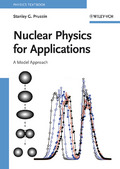Nuclear Physics for Applications
A Model Approach

1. Edition September 2007
XVI, 634 Pages, Softcover
241 Pictures
25 tables
Textbook
Short Description
This practical textbook gives advanced undergraduates minoring in physics a knowledge of nuclear physics. Simplifying models and approaches reveal the essence of the principles, while the mathematical and quantum mechanical background is integrated in the text where it belongs.
Written by a researcher and teacher with experience at top institutes in the US and Europe, this textbook provides advanced undergraduates minoring in physics with working knowledge of the principles of nuclear physics. Simplifying models and approaches reveal the essence of the principles involved, with the mathematical and quantum mechanical background integrated in the text where it is needed and not relegated to the appendices. The practicality of the book is enhanced by numerous end-of-chapter problems and solutions available on the Wiley homepage.
- Nuclear Masses and Energetics of Radioactive Decay and Nuclear Reactions
- Phenomenology of Radioactive Decay and Nuclear Reactions
- Nuclear Binding Energies: Empirical Data and the Forces in Nuclei
- The Semi-Empirical Mass Formula and Applications to Radioactive Decay
- Elements of Quantum Mechanics
- Nuclear Structure: The Spherical Shell Model
- Nuclear Shapes, Deformed Nuclei and Collective Effects
- Alpha Decay and Barrier Penetration
- Beta Decay
- Gamma Decay and Internal Conversion
- Nuclear Fission
- Low-Energy Nuclear Reactions
- The Interaction of Ionizing Radiation with Matter
- Appendix 1: Atomic Masses
- Appendix 2: Nuclide Table


